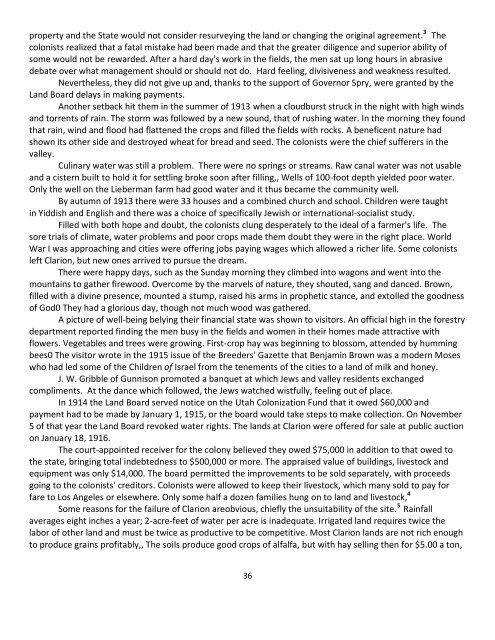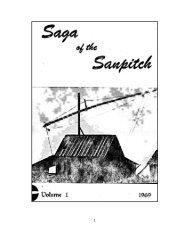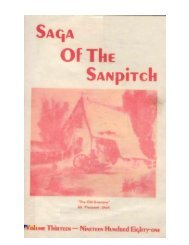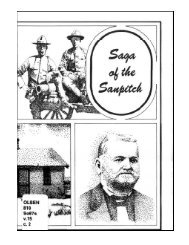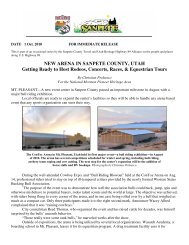Saga of the Sanpitch Volume 17, 1985 - Sanpete County
Saga of the Sanpitch Volume 17, 1985 - Sanpete County
Saga of the Sanpitch Volume 17, 1985 - Sanpete County
Create successful ePaper yourself
Turn your PDF publications into a flip-book with our unique Google optimized e-Paper software.
property and <strong>the</strong> State would not consider resurveying <strong>the</strong> land or changing <strong>the</strong> original agreement. 3 The<br />
colonists realized that a fatal mistake had been made and that <strong>the</strong> greater diligence and superior ability <strong>of</strong><br />
some would not be rewarded. After a hard day's work in <strong>the</strong> fields, <strong>the</strong> men sat up long hours in abrasive<br />
debate over what management should or should not do. Hard feeling, divisiveness and weakness resulted.<br />
Never<strong>the</strong>less, <strong>the</strong>y did not give up and, thanks to <strong>the</strong> support <strong>of</strong> Governor Spry, were granted by <strong>the</strong><br />
Land Board delays in making payments.<br />
Ano<strong>the</strong>r setback hit <strong>the</strong>m in <strong>the</strong> summer <strong>of</strong> 1913 when a cloudburst struck in <strong>the</strong> night with high winds<br />
and torrents <strong>of</strong> rain. The storm was followed by a new sound, that <strong>of</strong> rushing water. In <strong>the</strong> morning <strong>the</strong>y found<br />
that rain, wind and flood had flattened <strong>the</strong> crops and filled <strong>the</strong> fields with rocks. A beneficent nature had<br />
shown its o<strong>the</strong>r side and destroyed wheat for bread and seed. The colonists were <strong>the</strong> chief sufferers in <strong>the</strong><br />
valley.<br />
Culinary water was still a problem. There were no springs or streams. Raw canal water was not usable<br />
and a cistern built to hold it for settling broke soon after filling,, Wells <strong>of</strong> 100-foot depth yielded poor water.<br />
Only <strong>the</strong> well on <strong>the</strong> Lieberman farm had good water and it thus became <strong>the</strong> community well.<br />
By autumn <strong>of</strong> 1913 <strong>the</strong>re were 33 houses and a combined church and school. Children were taught<br />
in Yiddish and English and <strong>the</strong>re was a choice <strong>of</strong> specifically Jewish or international-socialist study.<br />
Filled with both hope and doubt, <strong>the</strong> colonists clung desperately to <strong>the</strong> ideal <strong>of</strong> a farmer's life. The<br />
sore trials <strong>of</strong> climate, water problems and poor crops made <strong>the</strong>m doubt <strong>the</strong>y were in <strong>the</strong> right place. World<br />
War I was approaching and cities were <strong>of</strong>fering jobs paying wages which allowed a richer life. Some colonists<br />
left Clarion, but new ones arrived to pursue <strong>the</strong> dream.<br />
There were happy days, such as <strong>the</strong> Sunday morning <strong>the</strong>y climbed into wagons and went into <strong>the</strong><br />
mountains to ga<strong>the</strong>r firewood. Overcome by <strong>the</strong> marvels <strong>of</strong> nature, <strong>the</strong>y shouted, sang and danced. Brown,<br />
filled with a divine presence, mounted a stump, raised his arms in prophetic stance, and extolled <strong>the</strong> goodness<br />
<strong>of</strong> God0 They had a glorious day, though not much wood was ga<strong>the</strong>red.<br />
A picture <strong>of</strong> well-being belying <strong>the</strong>ir financial state was shown to visitors. An <strong>of</strong>ficial high in <strong>the</strong> forestry<br />
department reported finding <strong>the</strong> men busy in <strong>the</strong> fields and women in <strong>the</strong>ir homes made attractive with<br />
flowers. Vegetables and trees were growing. First-crop hay was beginning to blossom, attended by humming<br />
bees0 The visitor wrote in <strong>the</strong> 1915 issue <strong>of</strong> <strong>the</strong> Breeders' Gazette that Benjamin Brown was a modern Moses<br />
who had led some <strong>of</strong> <strong>the</strong> Children <strong>of</strong> Israel from <strong>the</strong> tenements <strong>of</strong> <strong>the</strong> cities to a land <strong>of</strong> milk and honey.<br />
J. W. Gribble <strong>of</strong> Gunnison promoted a banquet at which Jews and valley residents exchanged<br />
compliments. At <strong>the</strong> dance which followed, <strong>the</strong> Jews watched wistfully, feeling out <strong>of</strong> place.<br />
In 1914 <strong>the</strong> Land Board served notice on <strong>the</strong> Utah Colonization Fund that it owed $60,000 and<br />
payment had to be made by January 1, 1915, or <strong>the</strong> board would take steps to make collection. On November<br />
5 <strong>of</strong> that year <strong>the</strong> Land Board revoked water rights. The lands at Clarion were <strong>of</strong>fered for sale at public auction<br />
on January 18, 1916.<br />
The court-appointed receiver for <strong>the</strong> colony believed <strong>the</strong>y owed $75,000 in addition to that owed to<br />
<strong>the</strong> state, bringing total indebtedness to $500,000 or more. The appraised value <strong>of</strong> buildings, livestock and<br />
equipment was only $14,000. The board permitted <strong>the</strong> improvements to be sold separately, with proceeds<br />
going to <strong>the</strong> colonists' creditors. Colonists were allowed to keep <strong>the</strong>ir livestock, which many sold to pay for<br />
fare to Los Angeles or elsewhere. Only some half a dozen families hung on to land and livestock, 4<br />
Some reasons for <strong>the</strong> failure <strong>of</strong> Clarion areobvious, chiefly <strong>the</strong> unsuitability <strong>of</strong> <strong>the</strong> site. 5 Rainfall<br />
averages eight inches a year; 2-acre-feet <strong>of</strong> water per acre is inadequate. Irrigated land requires twice <strong>the</strong><br />
labor <strong>of</strong> o<strong>the</strong>r land and must be twice as productive to be competitive. Most Clarion lands are not rich enough<br />
to produce grains pr<strong>of</strong>itably,, The soils produce good crops <strong>of</strong> alfalfa, but with hay selling <strong>the</strong>n for $5.00 a ton,<br />
36


